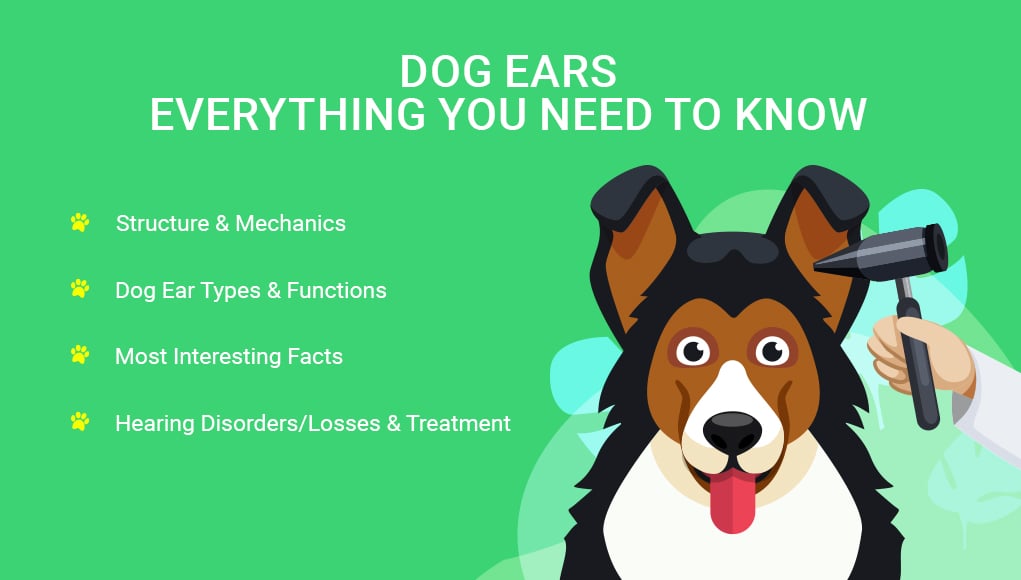You are probably familiar with the wonders a dog’s nose can perform. Their ability to sniff out missing people, bombs, and even distinct body scents with their 300 million scent receptors is out of this world. Here’s what’s also interesting. A dog’s nose is just as impressive as dog ears.
Though a dog’s hearing ability depends on their age and breed, their average hearing range is still between 67Hz–45,000Hz, which is about three times the capacity of humans. Unlike humans who cannot usually hear sounds above 23,000Hz (of which study has shown the limit of adult to be 20-20,000Hz), dogs have the ability to hear sounds as high as 45,000-60,000Hz (45-60KHz).
Let me explain it this way, it means dogs can both pick up sounds too soft for the human to hear and loud noises which they often hear at much higher frequencies that tend to scare them. They are also good in picking out specific sounds, especially when you call their names or whistle.
Have we caught your interest yet. Just like the nose of the dog, there is so much more to learn about their ears. In this article you will learn some amazing things. When your finished reading you will have everything you need to know about the dog’s ears: types, functions, fun facts, hearing disorders and how to treat and care for dog ears.
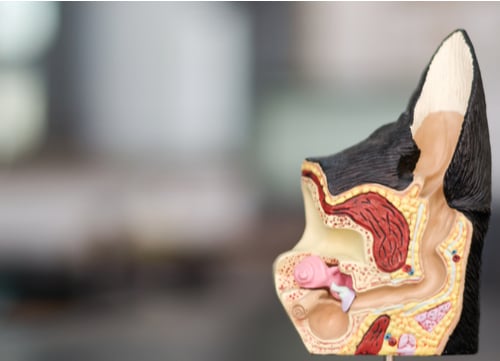
DOG EARS – Structure & Mechanics
Just like humans, dogs have ears as an organ for hearing and balance. They consist of the outer, middle and the inner sections.
The outer ear is the section that has the pinna and also the ear canal. The pinna is the one covered by the skin, fur or hair depending on the type/breed (which we will get into in the next section).
The pinna’s shape allows it capture sound waves and funnel them through the ear canal straight to the ear drum. The pinnae (plural of pinna) of dogs usually vary with breed and can move independent of each other. The ear canal is the passage through which the sound waves travel from outside into the ear drum.
The middle ear consists of a small air-filled chamber (having 3 little bones known as; hammer, anvil and stirrup) and the ear drum. This section also has the 2 muscles known as oval window and Eustachian tube. It is this Eustachian tube that connects the middle ear to the back of the nose.
Last but not the least, is the inner ear is a more complex structure that contain both the cochlea and the vestibular system. The cochlea is responsible for the organ of hearing while the vestibular system for the organ of balance.
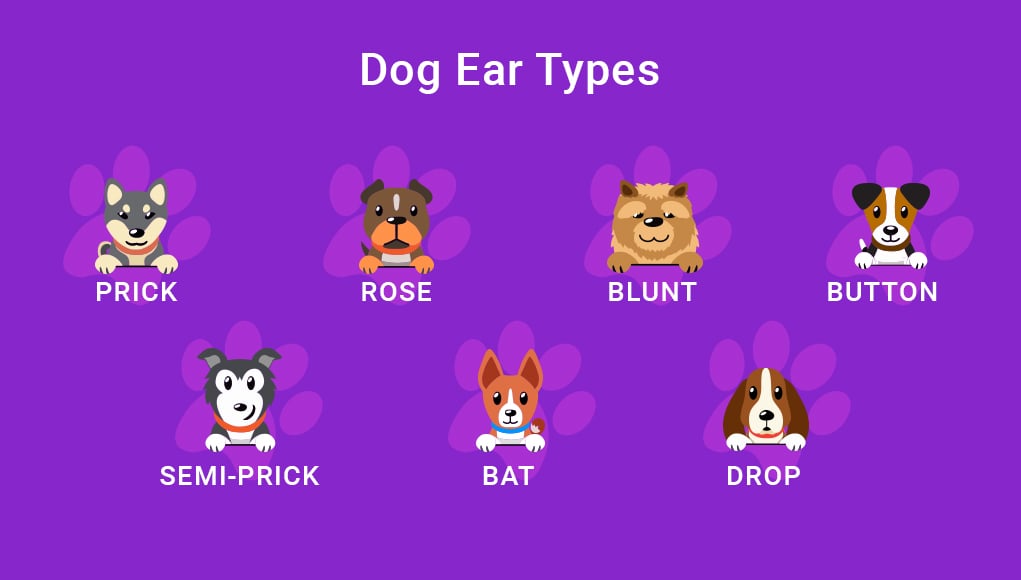
DOG EARS – Types
Amongst the wide variety of pinna shapes and sizes we have, here are 7 of the most common which I will share with you now. They are;
Prick
The prick ears are also known as erect ears because they stand fully upright. Two examples of dogs with prick ears are the Siberian Husky and the German Shepherd.
Semi-Prick
Unlike the prick ears, these stand fully upright except that they fold over when they do. Another name to call semi-prick ears is cocked or tipped ears. Two examples of dogs that have them are Shetland Sheepdog and the Collie.
Rose
For the Rose ears, they are erect at the base and at the same time slightly folded back. Two examples of breeds in this category are the Bulldog and the Greyhound.
Bat
The bat ears spread out like a V as they are fully upright and large in proportion to the head of the dog. Common examples of breeds with bat ears are the Chihuahua as well as the Cardigan Welsh Corgi.
Blunt
The blunt ears stand fully upright with rounded edges atop. They are also referred to as round-tipped ears. Two examples of breeds that have them are the Chow Chow and the French Bulldog.
Drop
Generally, dog’s ears who hang down completely are referred to as drop ears. Their names differ depending on those whose ears also fold. Another name for drop ears is pendant ears. This is what a layman sees and calls it floppy ears. Two examples of breeds that have them are the Cocker Spaniel and the Basset Hound.
Button
For the button ears, as the ears stand upright at the base, the top half of them fold over. The two examples of breeds that have them are the Jack Russell Terrier and the Airedale.
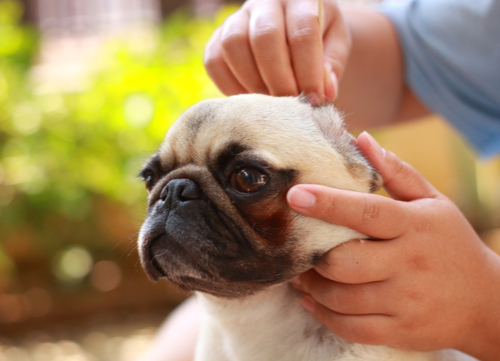
DOG EARS – Functions
The canine ears of a dog are controlled by a group of 18 muscles that make it possible for the dog to both tilt and rotate them. This way, the dog’s hearing is even more acute as it is able to capture sounds more effectively.
Internally, a dog’s ears may look similar to that of a human but is shaped much more differently. Unlike humans, their ear canals are L-shaped and even much deeper. Its shape is not only different but also better to allow to funnel sounds to ear drum. This explains why dogs are known for hearing very keenly.
Externally, the dog’s ears are also different and vary in types and breed as discussed in detail in the previous section.
DOG EARS – Most Interesting Facts
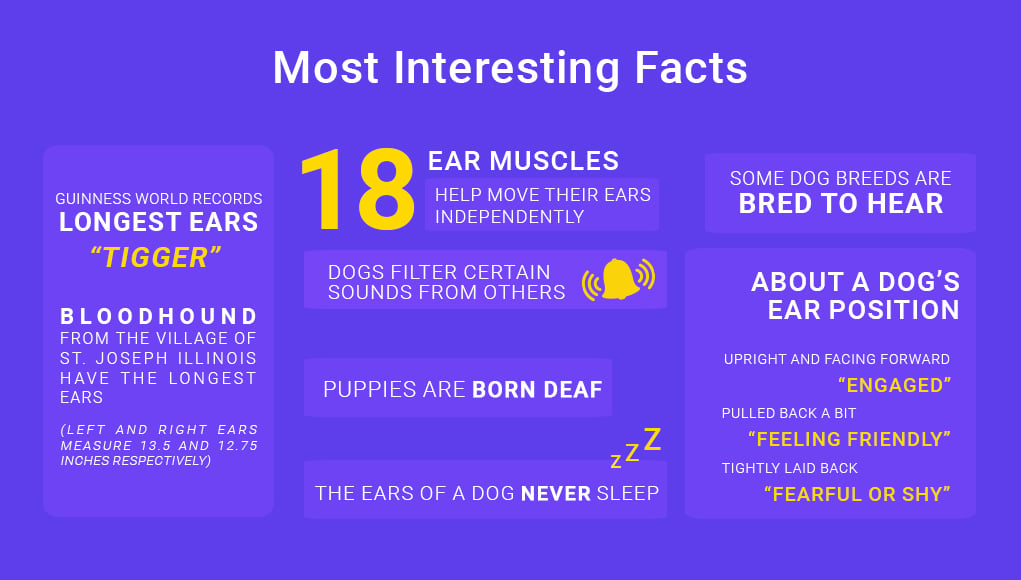
Sound Filter
One ability of dogs that makes them fascinating is their ability to filter certain sounds from others. When they do this, they remain alert to the sound they need to pick amidst others. This explains why your TV is loud and your dog can pick up the sound of a car that’s just pulled up right in front of your house. A dog sometimes cock their head to help them tune in sounds more, especially those that are really far off.
Ear Movement
Thanks to the number of muscles (around 18) in the dog’s ears, they can move their ears independently. Either it’s to turn, tilt or raise them, it is possible for them to show their facial expression as well as communicate their emotions per time.
Born Deaf
Puppies are born deaf. Why? Because their ear canals are still closed at birth, so they start hearing when they are a few weeks old.
Dogs vs. Cats
Though dogs can hear at a higher frequency than humans, they do not do so at the level of cats.
Bred to Hear
There are some dog breeds that are bred for specific tasks. A common example is Sheepdogs who serve as herding dogs. Once they pick the sound of predators coming or even generally any form of imminent danger, they can immediately herd the sheep to safety.
Signs of Attention
A dog’s attention span can be observed by paying attention to their ears. When your dog’s ears are upright and facing forward, they are engaged. Another case where they pulled back a bit, they are feeling friendly. But when their ears are tightly laid back, it signifies that they are either fearful or shy.
They Never Sleep
The ears of a dog neither rest nor stop working as long as they are alive. We as humans may not be able to tell because we don’t hear as much as they do. When we sleep, all is quiet and peaceful, but not for dogs. They are able to hear those seemingly unnoticeable sounds at high frequencies like the pulse of your alarm clock, electrical buzzing and surprisingly even the vibrations of termites in the walls.
Longest Ears
There is a Bloodhound from the village of St. Joseph Illinois who holds the Guinness World Records of having the longest ears. His left and right ears measure 13.5 and 12.75 inches respectively. The bloodhound's long ears aid in directing scents to their sensitive noses. Its name is Tigger.
Ear Canal
Finally, a dog’s ear canal has the form of an L shape. It is shaped vertical towards the jaw and having an almost 90° horizontally toward the ear drum. The upside to this is that it makes sound waves travel faster to the ear drum and hence dogs pick sounds keenly. However, the downside of this is examining a dog for hearing losses or disorders become a challenge as one cannot accurately tell what ear ailment the dog may be suffering from when the need arises.
DOG EARS – Hearing Disorders/Losses & Treatment
In this section, we will share the hearing disorders or losses that may occur in dogs and how to treat them once noticed. Here are some of the most common ear issues for dogs:
Ear Deafness
As we mentioned in the previous section, it is natural for dogs to be born deaf as their ear canals are closed at birth. This is also known as congenital deafness. However, it becomes an issue when they remain deaf after weeks of birth. This could be as a result of many factors, some of which are: severe or untreated ear infections, ear injury, degenerative disease, drug toxicity, noise trauma and sometimes even old age.
If you notice your dog exhibiting strange symptoms of ear deafness such as excessive shaking or tilting of their head and maybe being unresponsive to happenings that they formerly responded to like name-calling and other familiar sounds, the best move would be to consult your veterinarian so they check your dog’s hearing. Once they suspect hearing loss of your dog, they would need to use a brainstem auditory evoked response (also known as BAER) test so they can determine what may be wrong.
Ear Infections
The main cause of infections in dog’s ears is often due to an overgrowth of yeast and bacteria in them. It has been argued that compared to dogs with prick and semi-prick ears, dogs with drop ears are more prone to having these kinds of infections. This concept was based on the fact that floppy and folded ears get very little airflow in them and when water enter them, in moist environments especially, they are often trapped. It is in these kinds of environments these infections get to thrive causing complications.
Asides grouping our studies based on ear shapes, we could also look at another study based on breeds. For example, for breeds who have hair growing inside their ear canals (such as Poodles and Bichon Frise) in moist and warm environments, these hairs could be a contributing factor to infections getting in easily. Though some still disagree this to be untrue. While this argument is still ongoing, veterinarians have advised to remove the hairs in dog’s ears if and only if the infection becomes a recurrent one for that particular dog. This is because this will help both ways; first in removing the necessary debris in the ears as well as being able to inject the proper medications for the infection.
Ear mites
Ear mites are tough parasites that live in the ears of dogs. One way to determine dogs with ear mites is when you find them scratching their heads or ears at intervals. Another is when you see them having a strange dark-looking ear discharge.
The bright side to this is they are easy to treat. Despite how troublesome these parasites may be, with proper cleaning and medications by your veterinarian, you can treat the infections quickly.
Lastly, asides looking out for infections your dog’s ears may have, be more observant about the general well-being of their ears and hearing. Also avoid putting them too close to high-pitched noises especially from two or more sources. A common example is having the TV blaring in one corner and music playing in another.

FINAL THOUGHTS/CONCLUSION
Now that you know some of the amazing purposes a dog’s ears serve, I’m sure you would be more challenged to take better care of your dog. Remember, with great knowledge comes great responsibility. So, as a dog owner, be responsible for your dog by giving them the best care they deserve; not just for their ears but also for their overall well-being.
Read Next: Dog Ears 101: How to Care for Them and Prevent Problems



